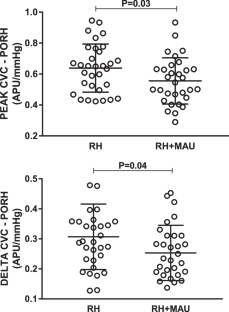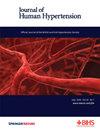Reduced systemic microvascular function in patients with resistant hypertension and microalbuminuria: an observational study
IF 2.7
4区 医学
Q2 PERIPHERAL VASCULAR DISEASE
引用次数: 0
Abstract
Resistant hypertension (RH) may be associated with microalbuminuria (MAU), a marker of cardiovascular risk and target organ damage, and both may be related to microvascular damage. Laser speckle contrast imaging (LSCI) is an innovative approach for noninvasively evaluating systemic microvascular endothelial function useful in the context of RH with or without MAU. Microalbuminuria was defined as a urine albumin-to-creatinine ratio between 30 and 300 mg/g. Microvascular reactivity was evaluated using LSCI to perform noninvasive measurements of cutaneous microvascular perfusion changes. Pharmacological (acetylcholine [ACh], or sodium nitroprusside [SNP]) and physiological (postocclusive reactive hyperemia [PORH]) stimuli were used to evaluate vasodilatory responses. Thirty-two patients with RH and a normal urine albumin-to-creatinine ratio (RH group) and 32 patients with RH and microalbuminuria (RH + MAU) were evaluated. Compared with patients without MAU, patients with RH + MAU showed reduced endothelial-dependent systemic microvascular reactivity, as demonstrated by an attenuation of microvascular vasodilation induced by PORH. On the other hand, ACh-induced vasodilation did not differ between groups. The results also revealed reduced endothelial-independent (SNP-induced) microvascular reactivity in hypertensive patients with MAU compared with patients without MAU. In this study, there was evidence of endothelial dysfunction associated with impaired microvascular smooth muscle function in patients with RH + MAU. This may suggest that patients with RH need more intensive therapeutic strategies for the control of blood pressure to avoid further vascular damage and the resulting consequences. The study was registered at ClinicalTrials.gov ( https://register.clinicaltrials.gov ) under protocol # NCT05464849, initial release 12/07/2022.


耐药性高血压和微量白蛋白尿患者全身微血管功能降低:一项观察性研究
耐药性高血压(RH)可能与微量白蛋白尿(MAU)有关,后者是心血管风险和靶器官损伤的标志物,两者都可能与微血管损伤有关。激光斑点对比成像(LSCI)是一种无创评估全身微血管内皮功能的创新方法,对伴有或不伴有MAU的RH非常有用。微量白蛋白尿的定义是尿白蛋白与肌酐的比率在 30 至 300 毫克/克之间。使用 LSCI 对微血管反应性进行评估,以对皮肤微血管灌注变化进行无创测量。药理(乙酰胆碱[ACh]或硝普钠[SNP])和生理(闭塞后反应性充血[PORH])刺激用于评估血管扩张反应。对 32 名患有 RH 且尿白蛋白与肌酐比值正常的患者(RH 组)和 32 名患有 RH 且有微量白蛋白尿的患者(RH + MAU)进行了评估。与无微量白蛋白尿的患者相比,RH + MAU 患者的内皮依赖性全身微血管反应性降低,表现为 PORH 诱导的微血管扩张减弱。另一方面,ACh 诱导的血管舒张在各组之间没有差异。研究结果还显示,与非 MAU 患者相比,患有 MAU 的高血压患者的内皮依赖性(SNP 诱导的)微血管反应性降低。在这项研究中,有证据表明,RH + MAU 患者的内皮功能障碍与微血管平滑肌功能受损有关。这可能表明,RH 患者需要更强化的治疗策略来控制血压,以避免进一步的血管损伤和由此导致的后果。该研究已在临床试验网(https://register.clinicaltrials.gov)注册,协议号为 NCT05464849,初始发布日期为 2022 年 7 月 12 日。
本文章由计算机程序翻译,如有差异,请以英文原文为准。
求助全文
约1分钟内获得全文
求助全文
来源期刊

Journal of Human Hypertension
医学-外周血管病
CiteScore
5.20
自引率
3.70%
发文量
126
审稿时长
6-12 weeks
期刊介绍:
Journal of Human Hypertension is published monthly and is of interest to health care professionals who deal with hypertension (specialists, internists, primary care physicians) and public health workers. We believe that our patients benefit from robust scientific data that are based on well conducted clinical trials. We also believe that basic sciences are the foundations on which we build our knowledge of clinical conditions and their management. Towards this end, although we are primarily a clinical based journal, we also welcome suitable basic sciences studies that promote our understanding of human hypertension.
The journal aims to perform the dual role of increasing knowledge in the field of high blood pressure as well as improving the standard of care of patients. The editors will consider for publication all suitable papers dealing directly or indirectly with clinical aspects of hypertension, including but not limited to epidemiology, pathophysiology, therapeutics and basic sciences involving human subjects or tissues. We also consider papers from all specialties such as ophthalmology, cardiology, nephrology, obstetrics and stroke medicine that deal with the various aspects of hypertension and its complications.
 求助内容:
求助内容: 应助结果提醒方式:
应助结果提醒方式:


